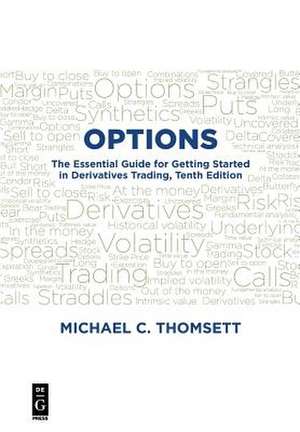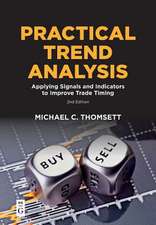Options: The Essential Guide for Getting Started in Derivatives Trading, Tenth Edition
Autor Michael C. Thomsetten Limba Engleză Paperback – 11 iun 2018 – vârsta de la 22 ani
Preț: 296.04 lei
Nou
56.65€ • 61.73$ • 47.73£
Carte disponibilă
Livrare economică 02-16 aprilie
Specificații
ISBN-10: 1547416149
Pagini: 450
Dimensiuni: 244 x 175 x 23 mm
Greutate: 0.89 kg
Editura: de-G Press
Cuprins
Part I: The Basics¿ 1
Chapter 1: Calls and Puts: Defining the Field of Play ¿ 3
Equity Investments ¿ 3
Debt Investments ¿ 4
Investments with No Tangible Value: Options ¿ 5
Trading Options on Exchanges ¿ 7
Calls and Puts ¿ 10
The Call Option ¿ 13
The Long-Term Call Option ¿ 20
Investment Standards for Call Buyers ¿ 21
How Call Selling Works ¿ 22
The Put Option ¿ 26
Option Valuation ¿ 32
Picking the Right Stock ¿ 37
Intrinsic Value and Time Value ¿ 38
Chapter 2: The Life of an Option ¿ 45
Expiration and Exercise ¿ 45
What is "Clearing"? ¿ 46
Bid and Ask ¿ 47
Order Entry ¿ 48
Types of Orders ¿ 49
Who Are the Players? ¿ 49
Chapter 3: Opening and Tracking: How It All Works ¿ 51
Terms of the Option (Standardized Terms) ¿ 51
Strike Price ¿ 51
Expiration Date ¿ 52
Type of Option ¿ 53
Underlying Stock ¿ 54
A Note on the Expiration Cycle ¿ 54
Opening and Closing Option Trades ¿ 56
Using the Daily Options Listings ¿ 56
Understanding Option Abbreviations ¿ 59
Calculating the Rate of Return for Sellers ¿ 61
Chapter 4: Buying Calls: Maximizing the Rosy View ¿ 65
Understanding the Limited Life of the Call ¿ 66
Judging the Call ¿ 70
Call Buying Strategies ¿ 76
Strategy 1: Calls for Leverage ¿ 76
Strategy 2: Limiting Risks ¿ 80
Strategy 3: Planning Future Purchases ¿ 81
Strategy 4: Insuring Profits ¿ 82
Strategy 5: Premium Buying ¿ 84
Strategy 6: Pure Speculation ¿ 85
Defining Profit Zones ¿ 87
Chapter 5: Buying Puts: The Positive Side of Pessimism ¿ 93
The Limited Life of the Put ¿ 95
Judging the Put ¿ 101
Put Buying Strategies ¿ 106
Strategy 1: Gaining Leverage ¿ 107
Strategy 2: Limiting Risks ¿ 109
Strategy 3: Hedging a Long Position ¿ 110
Strategy 4: Pure Speculation ¿ 114
Defining Profit Zones ¿ 115
Chapter 6: Selling Calls: Conservative and Profitable ¿ 119
Selling Uncovered Calls ¿ 121
Assessing Uncovered Call Writing Risks ¿ 126
A Question of Suitability ¿ 127
Selling Covered Calls ¿ 129
Assessing Covered Call Writing Risks ¿ 133
Calculating the Rate of Return ¿ 134
Chapter 7: Selling Puts: The Overlooked Strategy ¿ 139
Analyzing Stock Value ¿ 143
Evaluating Risks ¿ 145
Put Strategies ¿ 146
Strategy 1: Producing Income ¿ 147
Strategy 2: Using Idle Cash ¿ 149
Strategy 3: Buying Stock ¿ 150
Strategy 4: Writing a Covered Put on Short Stock ¿ 153
Strategy 5: Creating a Tax Put ¿ 153
Part II: Closing the Position ¿ 157
Chapter 8: Closing Positions: Profit, Exercise, or Roll ¿ 159
Defining Possible Outcomes of Closing Options ¿ 159
Results for the Buyer ¿ 160
Results for the Seller ¿ 160
Exercising the Option ¿ 162
Timing the Decision ¿ 168
Avoiding Exercise ¿ 171
Chapter 9: Paper Trading: A Test Run of the Theory ¿ 183
The Case for Paper Trading ¿ 185
Sites Worth Checking ¿ 187
www.Optionsxpress.com ¿ 187
marketwatch.com ¿ 188
www.investopedia.com ¿ 188
Proceeding with a Paper Trading Plan ¿ 188
The Dangers of Paper Trading ¿ 189
Chapter 10: Calculating the Return: A Complex Aspect to Options ¿ 193
Finding a Realistic Method ¿ 193
Annualizing Models and Guidelines ¿ 195
An Overview of Basic Calculations for Calls ¿ 198
You Close the Position and Calculate Option-Based Net Return ¿ 199
You Close the Position and Calculate Net Return Based on the Entire
Position ¿ 199
The Covered Call is Exercised, and You Calculate Option and Stock Profits
Separately ¿ 200
Any Covered Call Outcome Is Computed Strictly Based on Capital on
Deposit ¿ 200
Anticipating the Likely Return ¿ 201
Chapter 11: The Basics of Risk: What Every Trader Needs to Know ¿ 205
Volatility as the Definition of Risk ¿ 205
Historical Volatility ¿ 207
Implied Volatility ¿ 210
Pricing Models ¿ 213
Risk and Human Nature ¿ 215
Confirmation Bias ¿ 216
Anchoring ¿ 216
Herding ¿ 217
Framing ¿ 217
Selective Memory ¿ 218
Loss Aversion ¿ 218
Chapter 12: Strategies in Volatile Markets: Uncertainty as an Advantage ¿ 221
Avoiding 10 Common Mistakes ¿ 222
Modifying Your Risk Tolerance ¿ 228
The Nature of Market Volatility ¿ 229
Market Volatility Risk ¿ 230
Options in the Volatile Environment ¿ 235
Part III: Advanced Strategies ¿ 241
Chapter 13: Combinations and Spreads: Creative Risk Management ¿ 243
Overview of Advanced Strategies ¿ 246
The Spread ¿ 246
The Hedge ¿ 251
The Straddle ¿ 252
The Strangle ¿ 253
Vertical Spread Strategies ¿ 255
Bull Spreads ¿ 256
Bear Spreads ¿ 258
Box Spreads ¿ 262
Debit and Credit Spreads ¿ 265
Horizontal and Diagonal Spread Strategies ¿ 265
Altering Spread Patterns ¿ 270
Varying the Number of Options ¿ 271
Expanding the Ratio ¿ 274
Strategies with Moneyness Close to Underlying Prices ¿ 277
Variations on the Butterfly ¿ 280
Multi-Leg Option Orders ¿ 281
In Conclusion ¿ 282
Chapter 14: Hedges and Straddles: More Creativity ¿ 283
The Two Types of Hedges ¿ 283
Hedging Beyond Coverage ¿ 286
Hedging Option Positions ¿ 288
Partial Coverage Strategies ¿ 292
Straddle Strategies ¿ 295
Middle Loss Zones ¿ 295
Middle Profit Zones ¿ 298
Theory and Practice of Combined Techniques ¿ 301
In Conclusion ¿ 302
Chapter 15: Options for Specialized Trading: Leveraging the Technical
Approach ¿ 303
Swing Trading Basics ¿ 305
The Setup Signal ¿ 308
Testing the Theory ¿ 311
A Strategic View of Option for Swing Trading ¿ 313
Selection of Stocks Based on Value ¿ 313
A Stock's Price Volatility ¿ 314
Price History (Recent and Potential) ¿ 315
The Price-To-Earnings (P/E) Ratio of the Stock ¿ 315
Fundamental and Technical Tests of the Company and Stock ¿ 316
Options Used for Other Trading Strategies ¿ 316
Swing- and Day-Trading Advanced Strategies ¿ 317
Taking Partial Profits ¿ 318
Partial Exercise ¿ 319
Add More Option Contracts in Times of Price Momentum ¿ 319
In Conclusion ¿ 320
Chapter 16: Options on Futures: Leveraging Your Leverage ¿ 321
Important Distinctions ¿ 322
Regulatory Differences ¿ 326
In Conclusion ¿ 328
Chapter 17: Synthetic Positions: Tracking the Stock ¿ 331
Synthetic Put (Protected Short Sale) ¿ 333
Synthetic Long Call (Insurance Put, or Married Put) ¿ 334
Synthetic Long Stock ¿ 336
Synthetic Short Stock ¿ 338
Split Strike Strategy (Bullish) ¿ 340
Split Strike Strategy (Bearish) ¿ 342
Collars ¿ 343
Synthetic Straddles ¿ 350
In Conclusion ¿ 353
Part IV: Risk Evaluation ¿ 355
Chapter 18: Risk: Rules of the Game ¿ 357
Identifying the Range of Risk ¿ 357
Margin and Collateral Risk ¿ 360
Personal Goal Risks ¿ 360
Risk of Unavailable Market ¿ 361
Risk of Disruption in Trading ¿ 362
Brokerage Risks ¿ 363
Trading Cost Risk ¿ 363
Lost Opportunity Risks ¿ 364
Tax Consequence Risk ¿ 365
Evaluating Your Risk Tolerance ¿ 366
In Conclusion ¿ 367
Chapter 19: Taxes: The Wild Card of Options Trading ¿ 369
Tax Rules for Options ¿ 369
Qualified Covered Calls-Special Rules ¿ 373
Looking to the Future ¿ 378
In Conclusion ¿ 379
Chapter 20: Choosing Stocks: Finding the Right Ingredients ¿ 381
Developing a Covered Call Action Plan ¿ 385
Selecting Stocks for Call Writing ¿ 387
Benefiting from Price Appreciation ¿ 388
Analyzing Stocks ¿ 390
Fundamental Tests ¿ 394
Technical Tests ¿ 398
Deciding Which Tests to Apply ¿ 400
Applying Analysis to Options-the "Greeks" ¿ 401
Beta ¿ 402
Delta ¿ 402
The Rest of the Greeks ¿ 404
Acting on Good Information ¿ 406
Putting Your Rules Down on Paper ¿ 407
In Conclusion ¿ 408
Glossary ¿ 409
Index ¿ 409





















